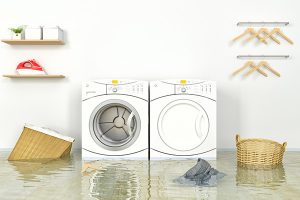 Whether day or night, weekdays or weekends, the average American family throws in 8 to 10 loads of laundry per week. A typical washing machine uses at least 30 gallons of water.– about the amount to fill a standard bathtub. With numbers like that, your chances of having a serious flood in your laundry room are high. If you are home when your machine overflows, you might be able to stop the flow immediately and oak up a cup or two of water without much trouble. But if you didn’t discover the problem for hours (or days), you’ll probably need some clean-up help.
Whether day or night, weekdays or weekends, the average American family throws in 8 to 10 loads of laundry per week. A typical washing machine uses at least 30 gallons of water.– about the amount to fill a standard bathtub. With numbers like that, your chances of having a serious flood in your laundry room are high. If you are home when your machine overflows, you might be able to stop the flow immediately and oak up a cup or two of water without much trouble. But if you didn’t discover the problem for hours (or days), you’ll probably need some clean-up help.
Common Causes Of Laundry Room Floods
When you are doing 400 or more loads a year, you’d assume the most common cause is too much water pressure. But it is actually the opposite. A low water supply can cause the washer drain to overflow. When there isn’t enough pressure flowing through your pipes, the water inlet valve doesn’t get the signal. It can’t trip the switch to shut off and halt the flow of water.
Another opportunity for an overflow is a problem that happened months or years ago during installation. Most washing machines require a standpipe at least 36 inches in height. A standpipe that is too low might overflow from the standpipe itself. One that is too tall will make the machine work harder to pump drained water up to the standpipe.
Another hidden issue could be how the drain was set up. A laundry tub should only flow into a floor drain when the floor drain connects directly to the main sewer system pipe. Never let your laundry tub drain into a floor drain that leads straight to a sump pit.
Bonus Tips
- Use mesh lint catchers that attach to the end of your washing machine drain pipe. A little bit of ingenuity and maintenance can prevent a future clog.
- Measure the correct amount and type of detergent. If you have a high-efficiency unit, you must use HE detergent. Too many suds with low water levels lengthen the wash cycle and could overflow the machine.
- Drain pans are inexpensive protection that catches small leaks and reduces the amount of damage from a broken hose. If your laundry room is upstairs, that $25 drain pan will save you from hundreds of dollars of damage to the ceiling below.
Steps to Remedy The Situation
If you discover a flood in your laundry room, you need to take action immediately. Get to the water line and turn off the water. Before you even diagnose the cause of the washer overflow, this step will help prevent a bigger problem. If water is still flowing in, turn off your main water supply line to stop the problem. The shut-off valve is in your yard, near the street. If you can’t immediately locate it, call Bravo Restoration now– keep looking for the shut-off while the clean-up team is in route. First, they will stop the flow of water and unplug the washer. After assessing the situation, they will organize an efficient workflow, usually including:
- Pump outstanding water, empty the washer
- Remove damaged building materials (drywall, flooring, molding)
Next, they will focus on repairing and restoring the space. This period will get loud!
- Dry flooded area with fans, humidifier, and air blowers
- Disinfect all surfaces
- Restore and rebuild any damaged areas.
Call for Help With Water Damage Cleanup In San Rafael
Bravo Restoration & Construction is a full-service property restoration and general contractor in the Bay Area. Locally woman-owned and operated, call them for stressful home situations. To request a quote, to report a claim, or to pre-register, please call for a quick response.

